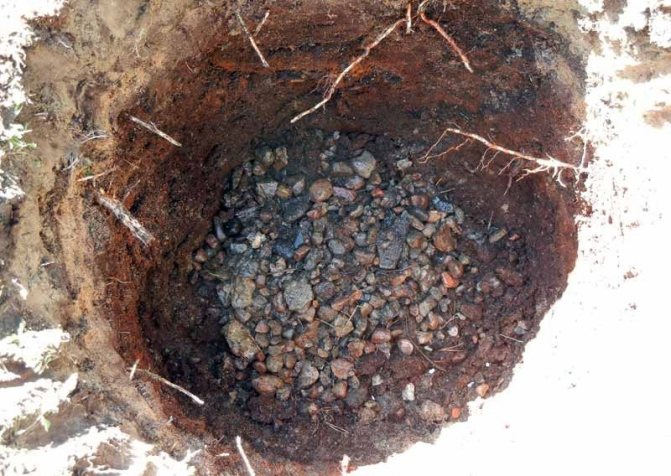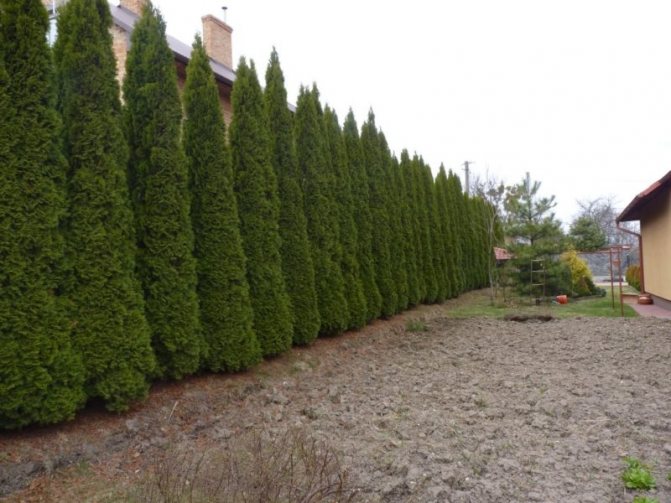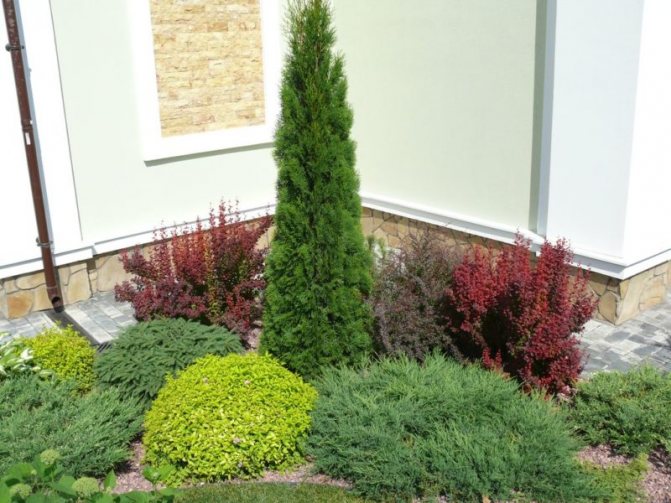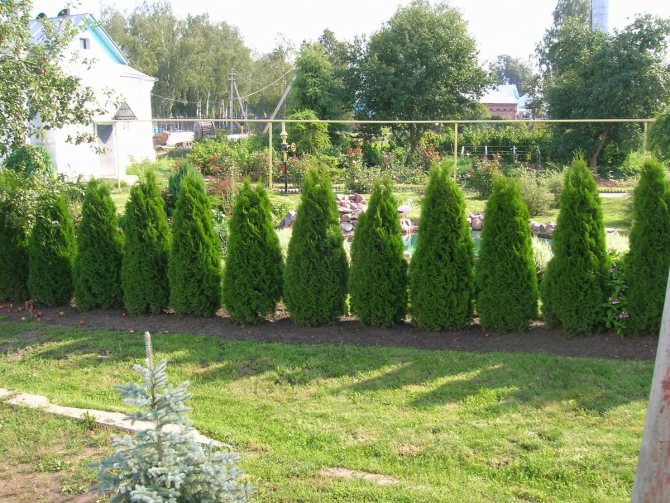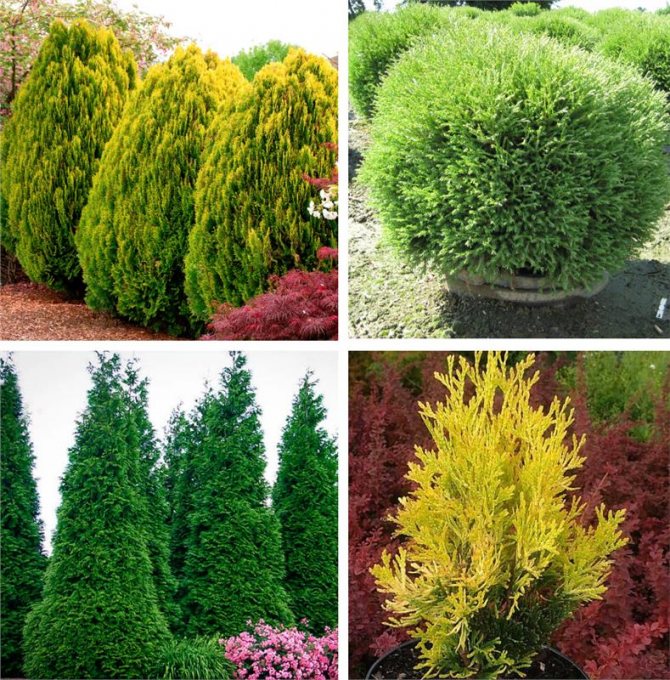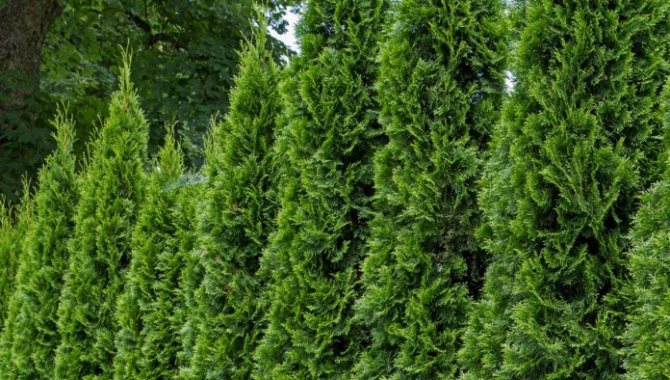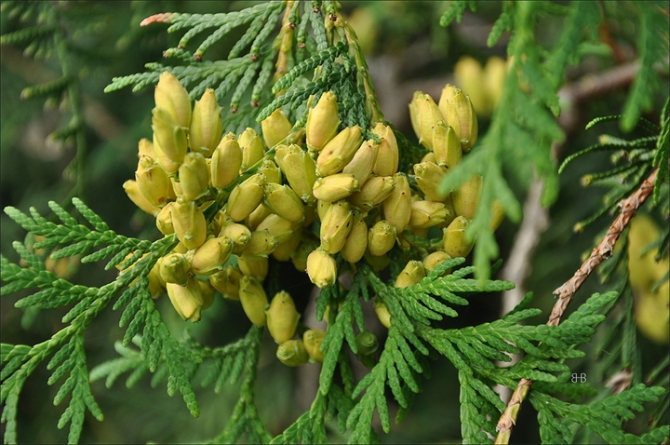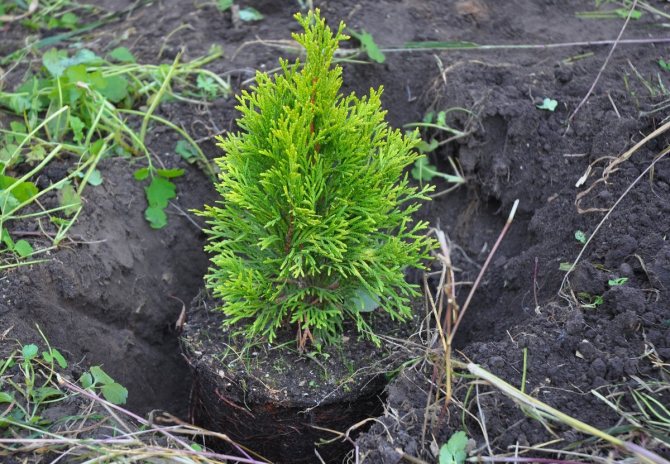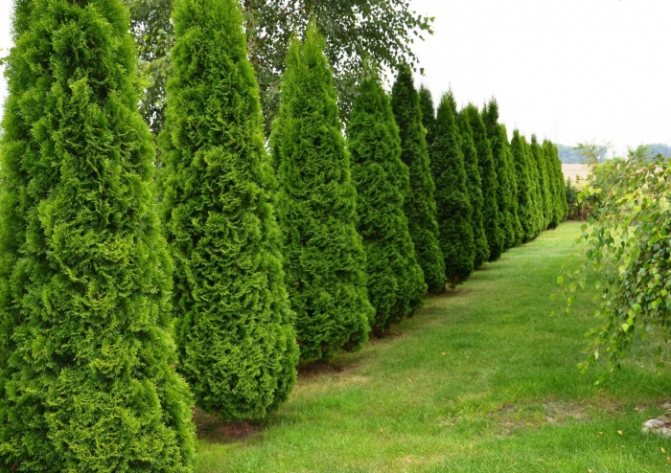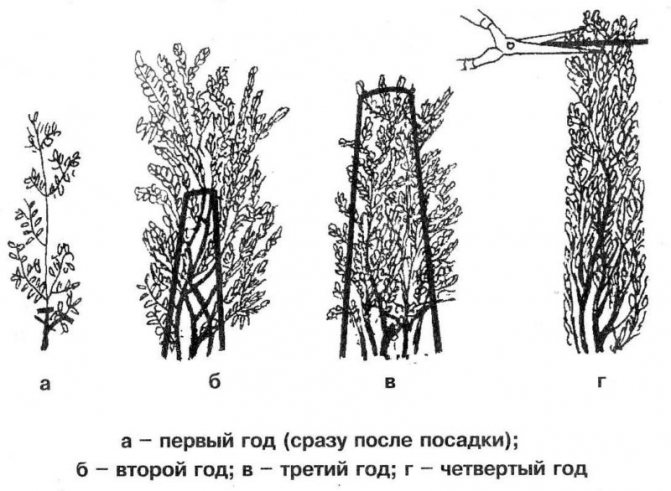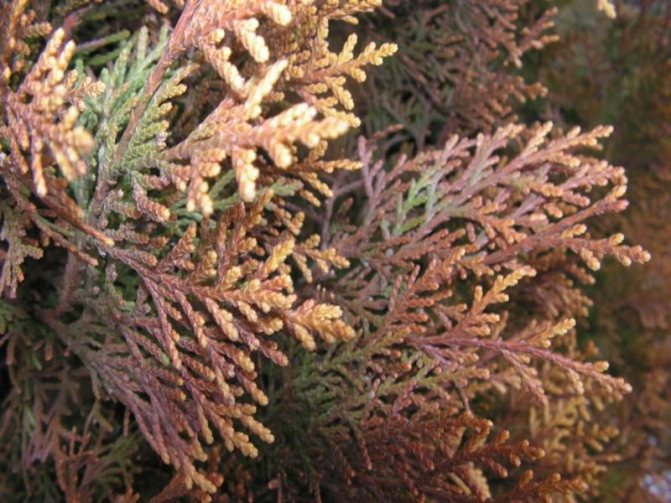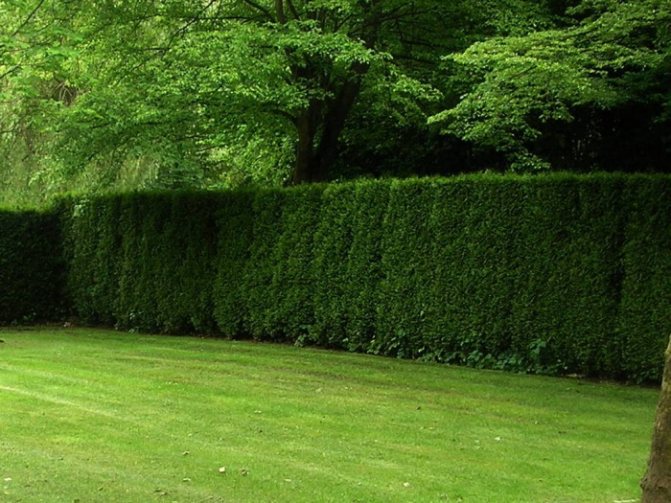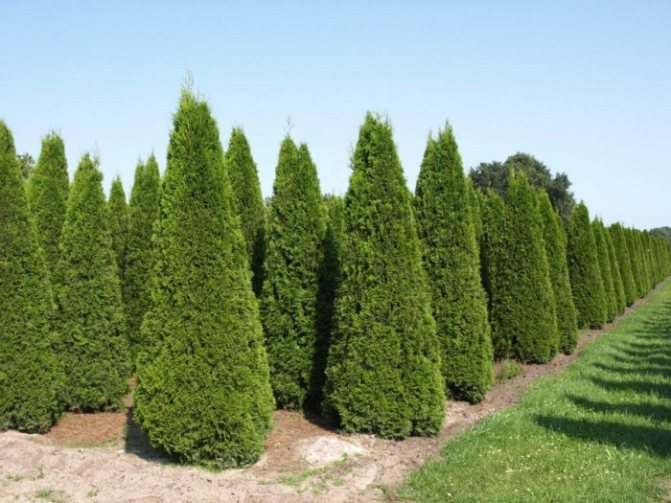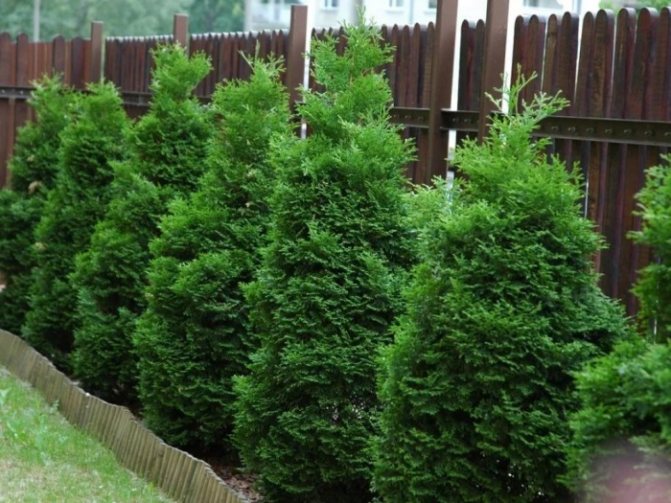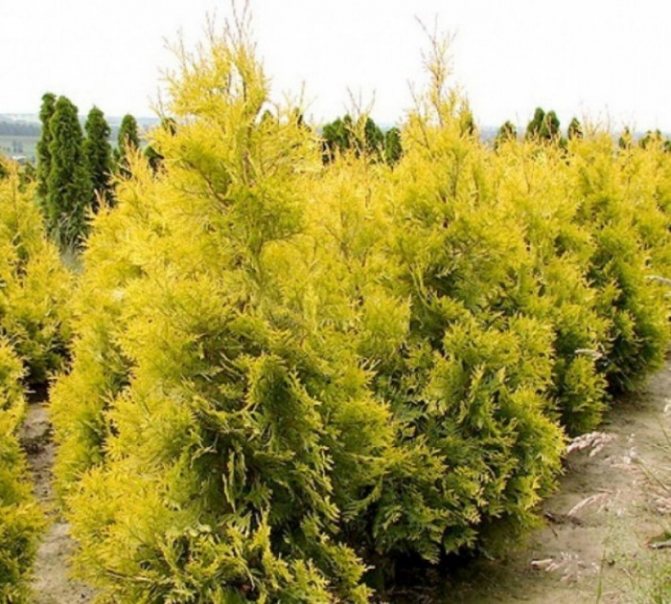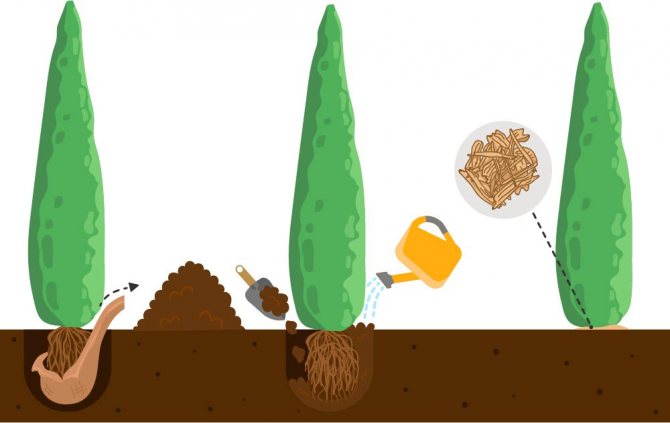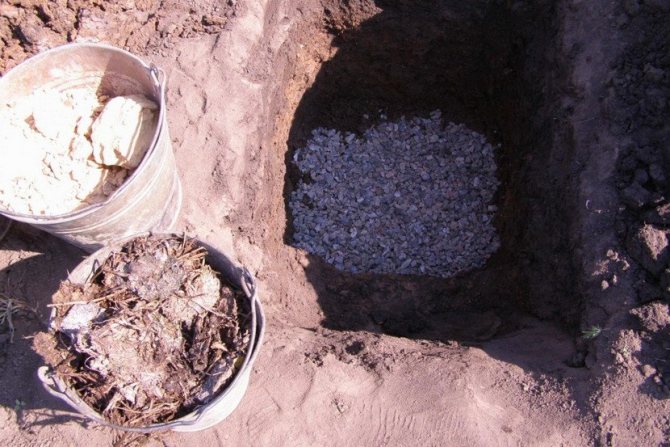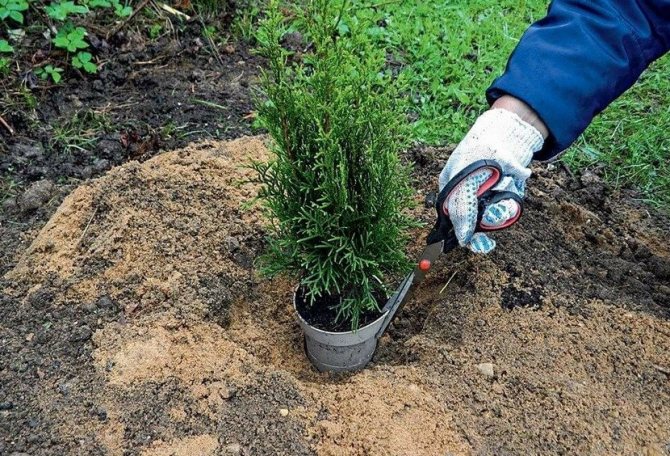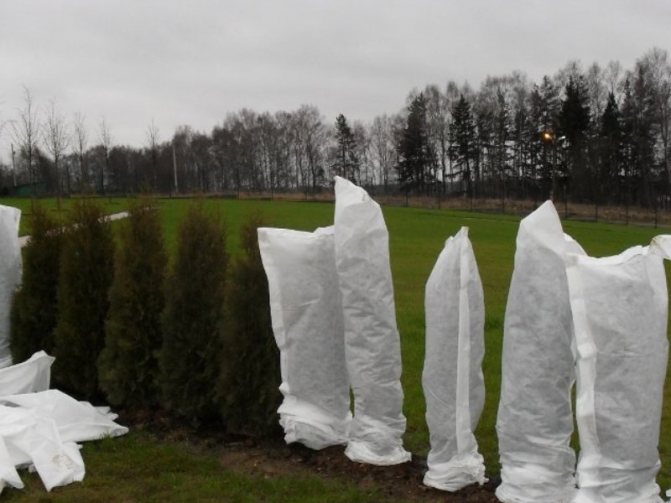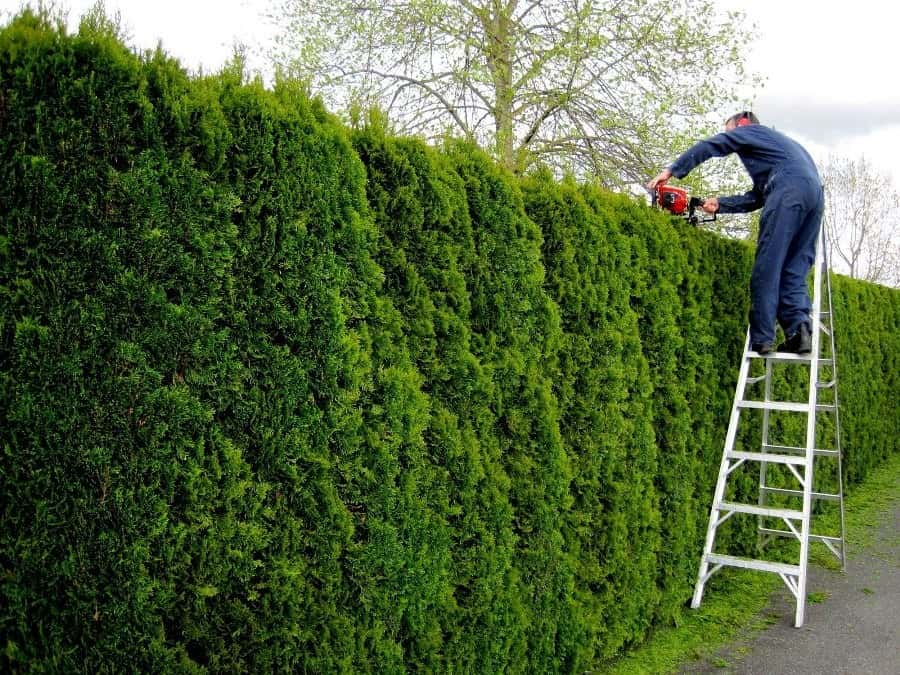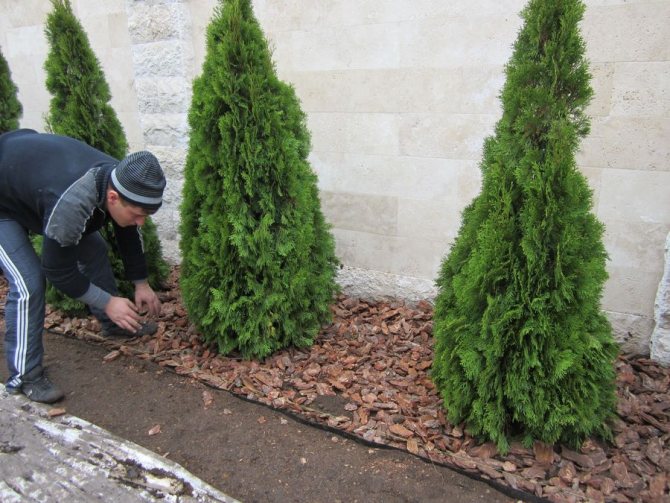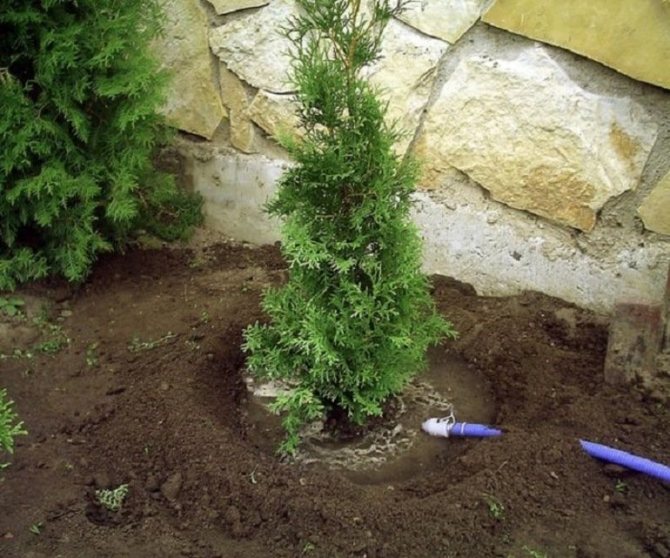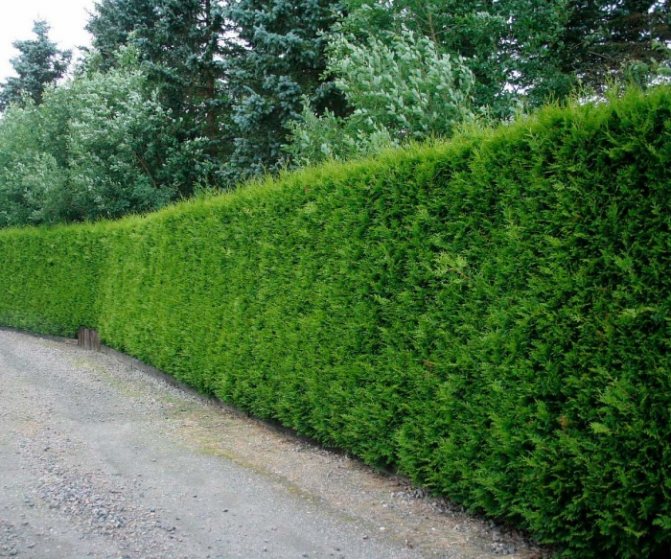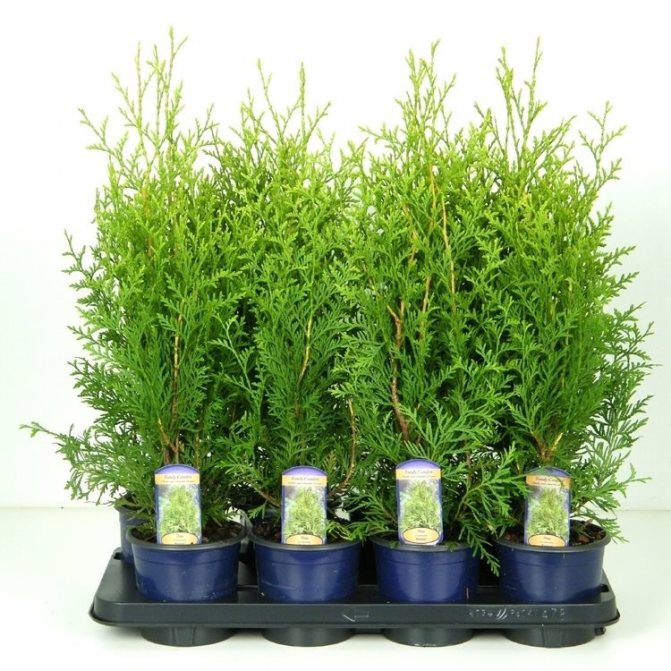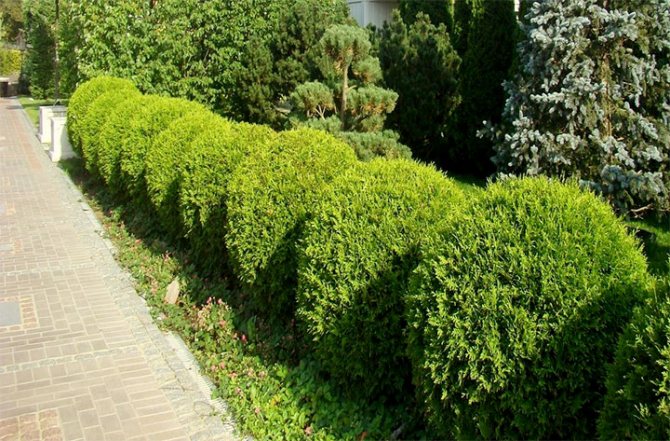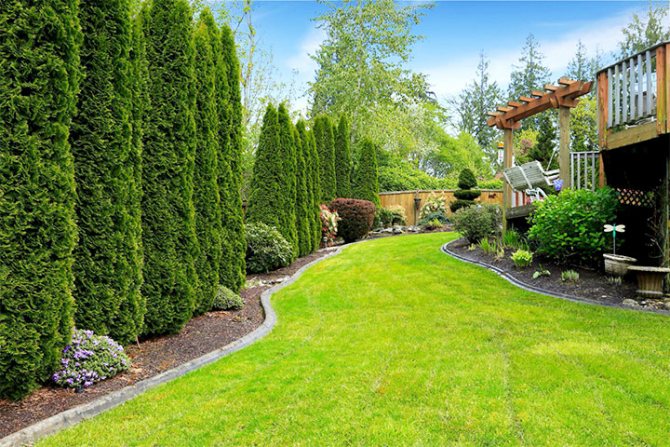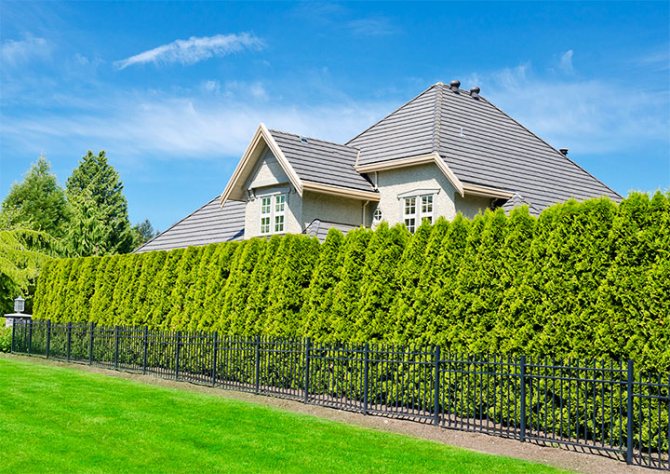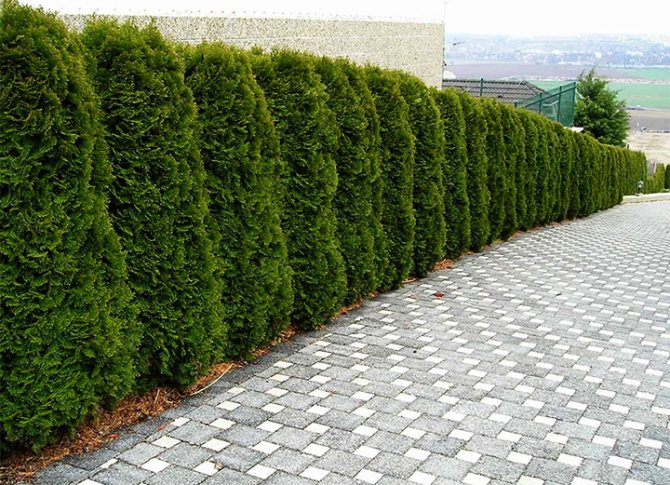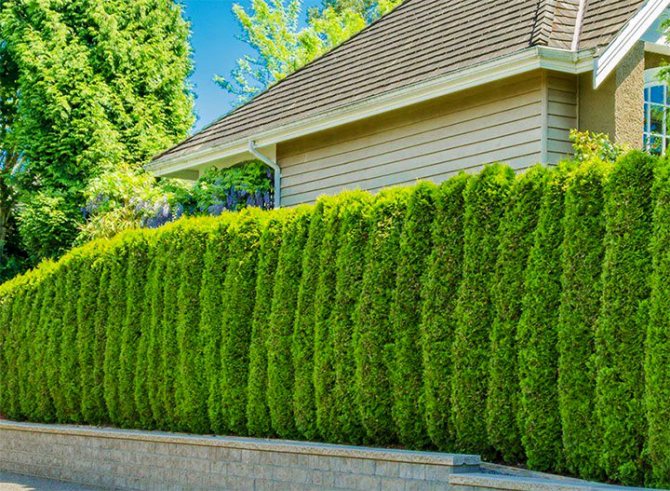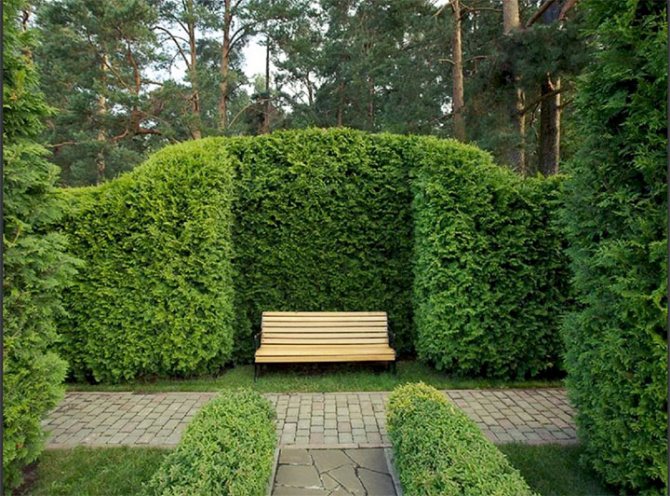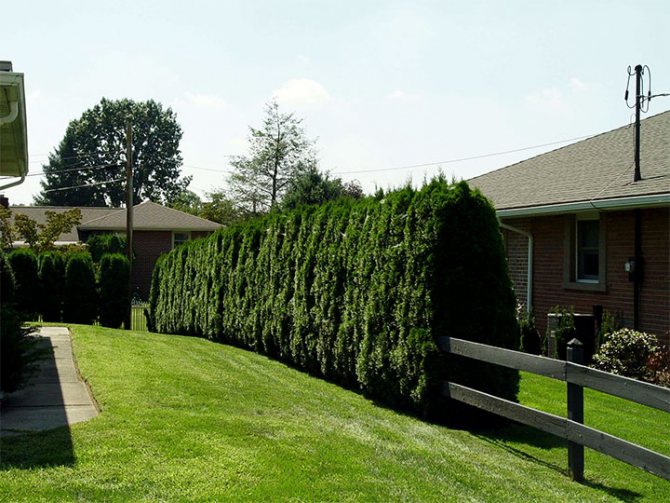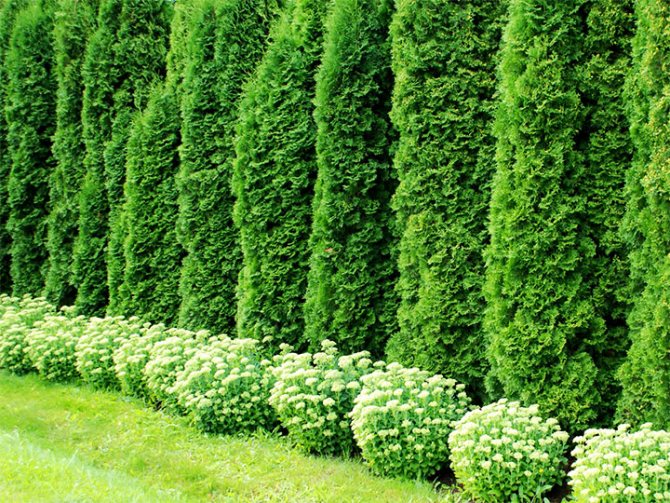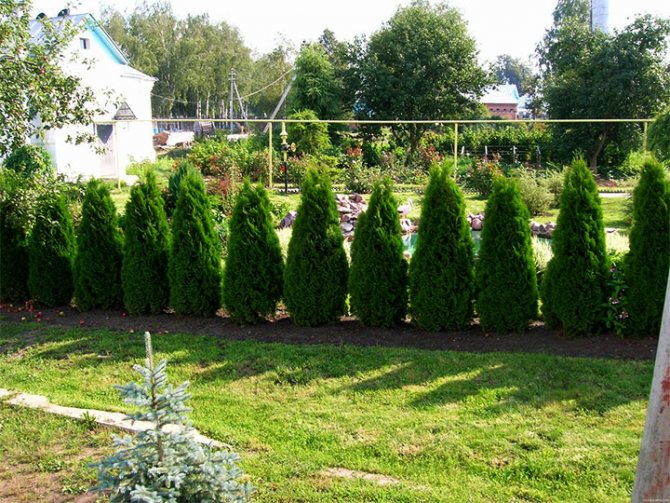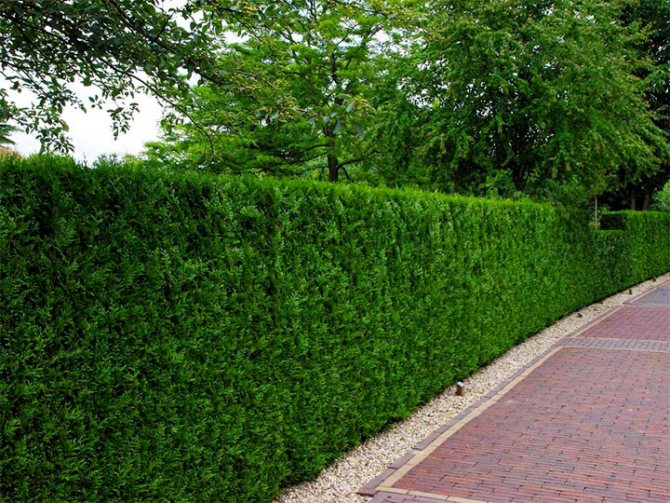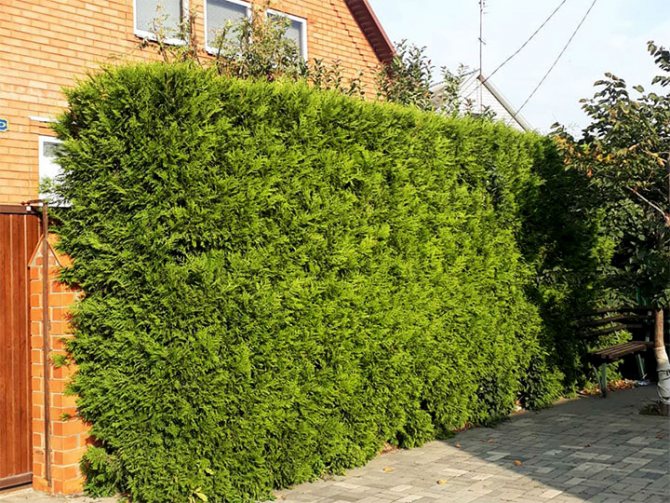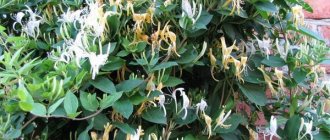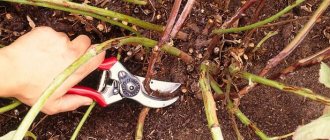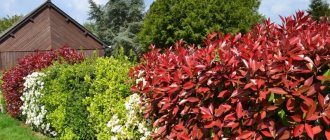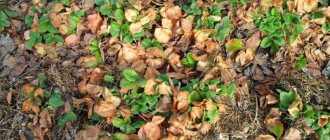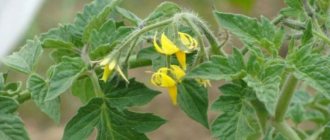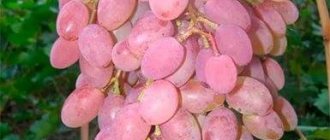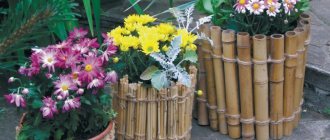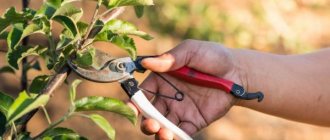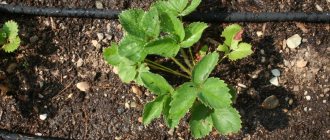Thuja is a wonderful solution for creating a hedge, this plant is chosen by most gardeners.
She was loved for its unpretentiousness, pliability of formation and relatively fast growth. Tuya can also perfectly hide your site from hostile views, curious people, strong winds, dust and even noise, not to mention a gorgeous background for your garden compositions on the site.
Inside the site, Tuya can still act as a delimiter of the territory, and the correct selection of the variety will help you choose the desired height.
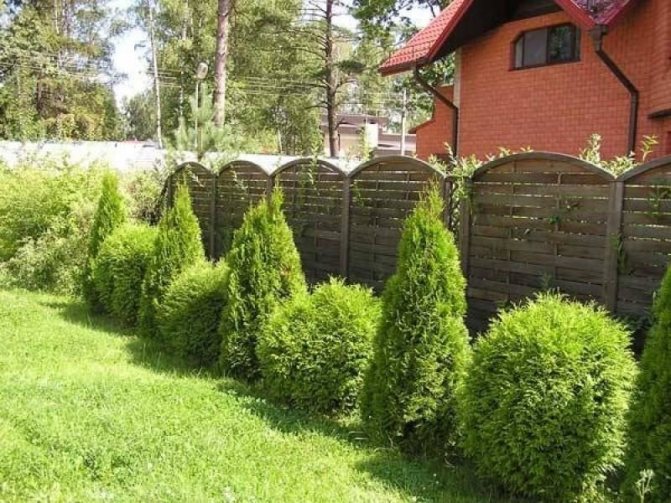
Benefits
Thuja is an evergreen tree popular for hedges. It is good because:
- improves the ecology of the site;
- unpretentious in care;
- does not respond to temperature extremes and drought;
- lends itself well to forming;
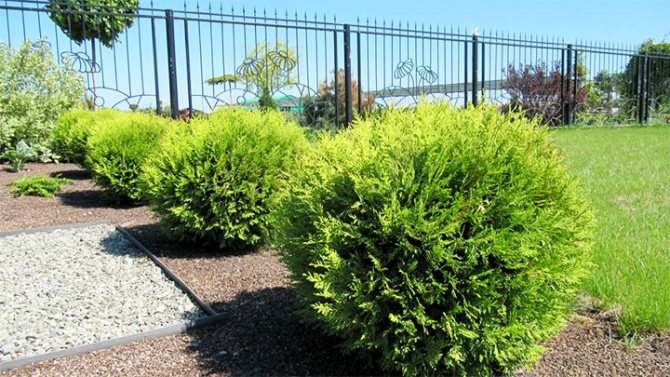

- available as shrub and tree;
- maintains a pleasant appearance all year round;
- not demanding on the soil, it takes root almost everywhere;
- grows rapidly, forming a hedge in the first year.
The thuja hedge has no drawbacks, so it is increasingly being chosen as an ornament for suburban areas throughout Russia.
What should not be planted next to the thuja?
It is not recommended to plant any fruit crops near the thuja, as their yield can significantly decrease. This applies to both shrubs (currants, gooseberries, raspberries, etc.) and plantings with berries or fruit trees. Also, some trees can become competitors of thuja in the fight for nutrients, for example, birch or bird cherry - conifers will lose in this fight.
Gardeners also need to take into account the fact that thuja quickly absorb moisture, and this can interfere with the development of neighboring plants, which do not tolerate being well in dry soil. It is undesirable to plant nearby bushes of Mahonia, jasmine.
Important! Do not plant flowering annuals next to thujas
—
with annual digging of the soil, the root system of conifers will be damaged.
The best varieties of thuja for hedges
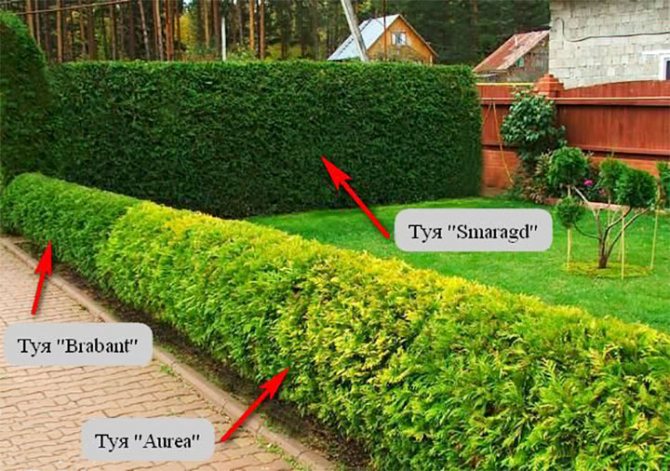

All varieties of thuja can be divided into several main groups:
- dwarf plants - it is convenient to form curbs and small curly decorations on the site from them;
- bushy - the main varieties that are planted in groups to create a hedge;
- solitary trees - trees that are planted one by one to create impressive barriers.
Shrubs are classified as Western and Eastern. For the Russian climate, western varieties of thuja are optimal. The choice depends not only on the climate, but also on how the hedge will eventually look. Someone wants a low fence, and someone wants a higher hedge.
Brabant
This is one of the most hardy varieties. Easy to cut and grows in any kind of soil. This is a fast growing variety of thuja, so it is suitable for those who dream of growing a hedge as soon as possible. The disadvantages include a change in the color of the crown. In winter, the thuja of this variety turns red. Brabant requires a little more maintenance than other varieties.
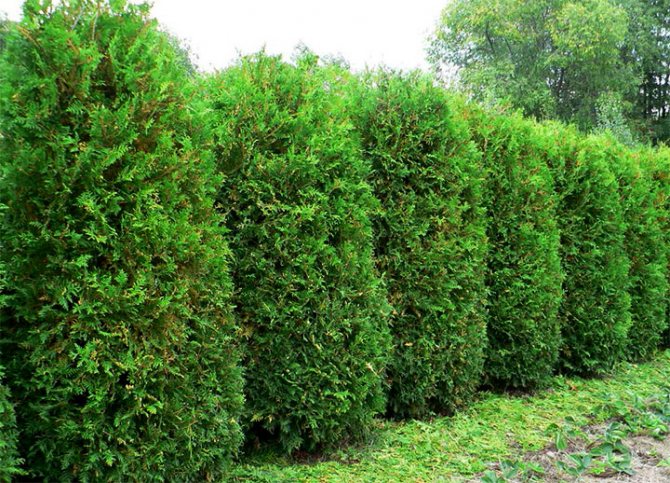

Emerald
Thuja of this variety grows more slowly, and does not require frequent cutting. The crown does not change color throughout the year. This evergreen plant will retain the appearance of the site in summer and winter. The variety requires regular watering. She has a positive attitude towards a haircut, it is from this variety of thuja that various shapes can be made on the site.
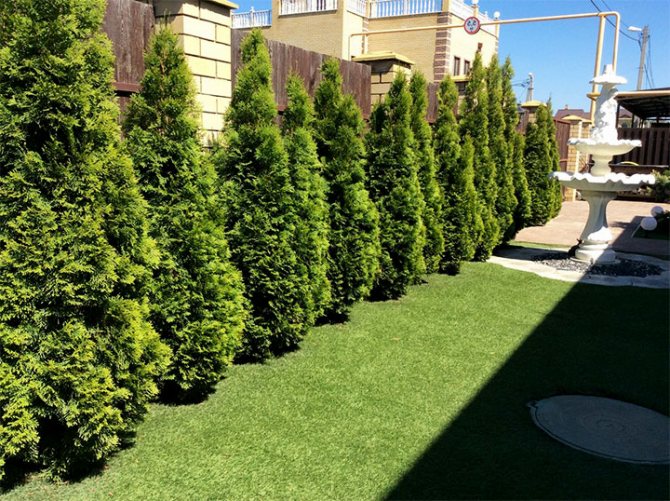

Pyramidalis compact
Western variety of thuja, 5-10 m tall, with a compact conical crown. At a young age, the crown of the tree is narrow, expanding with age. Loves sunny areas, grows on any soil, but fertile loam is best suited for it. It grows well in urban conditions and reacts positively to a haircut.
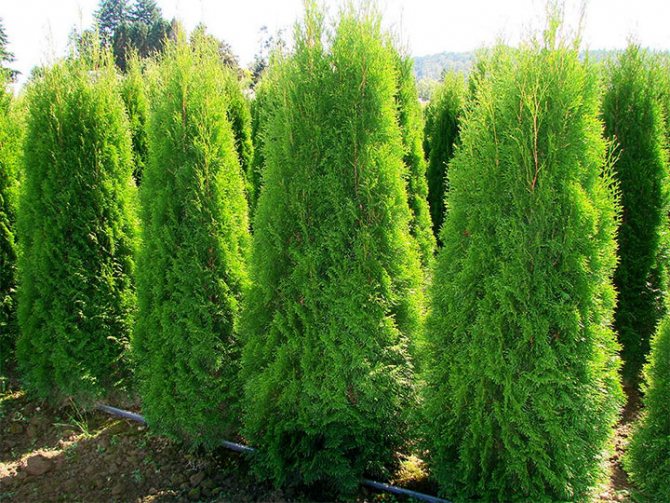

Columna
A tree with a crown in the form of a narrow cone up to 8 meters high. The branches are at right angles to the trunk. The tree tolerates shearing well. It belongs to the fast-growing species of thuja, forms a hedge in the first year. Columna easily tolerates frosts in the middle regions, takes root well in urban conditions.
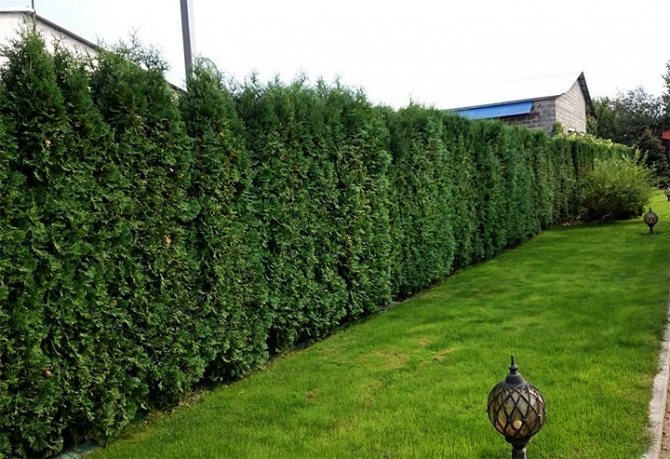

Spiralis
It got its name from the crown, which resembles a spiral. The plant gets this type because of the shoots, which, during growth, twist around their axis. If the tree lives in comfortable conditions, then the growth can be 30 cm per year.
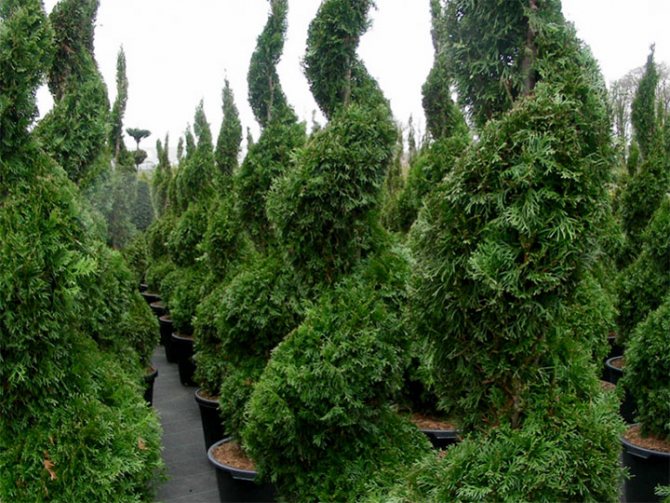

Recommended reading:
- Living willow fence
- Living fence of climbing plants
How to feed thuja for growth
Before planting, it is necessary to prepare the soil for the thuja. To do this, mix garden soil with 3 kg of wood ash, 1 bucket of humus, 1 bucket of compost. If you just add these dressings to the planting hole, you can burn the roots, so ash, humus and compost are mixed with the soil.
How to feed thuja for growth? Immediately after planting, the green beauty can be watered with a solution of the zircon preparation. It not only stimulates root formation, but also has antifungal and antiviral properties.
Important! Fresh manure cannot be used for feeding, for a plant this is certain death.
For 2-3 years after planting, the conifers do not need to be fertilized, the top dressing introduced into the planting hole will be quite enough for this time. If the thuja shows signs of wilting, then the nutrients can be added earlier.
The choice of mineral or organic fertilizer depends on how quickly you need to act. Mineral dressings start working immediately after application. They are an ambulance for thuja, but they do not last long.
Organic matter acts more slowly, nutrients are released gradually, so this feeding is enough for a longer time.
The best fertilizers for these trees:
- a growth stimulator of agriculture, which contains manganese, molybdenum, nitrogen, phosphorus, potassium, etc .;
- ammonium nitrate containing sulfur and nitrogen. Promotes the formation of a more lush and vibrant crown. For feeding, 30 g of nitrate is diluted in 10 liters of water. Each plant requires 5 liters. They are brought in in the spring;
- bone meal, which contains nitrogen, potassium, phosphorus, calcium. 150 g of powder is applied under each tree, scattered around the trunk and embedded in the soil. For heavy clay soils, this organic matter in an amount of 0.5 kg is diluted in 10 liters of water and slightly warmed up for better dissolution. The bone meal solution is not brought to a boil.
How to choose seedlings
To make the hedge beautiful, you need to buy seedlings from specialized nurseries. So there is a guarantee of the authenticity of the variety. Plants must be in containers in which they grew. In the market, seedlings are often sold with open roots. If the roots break off, then it is better to abandon the purchase.
Young seedlings can be easily identified by their crown. It should be bright green in color with no signs of lethargy or dryness.
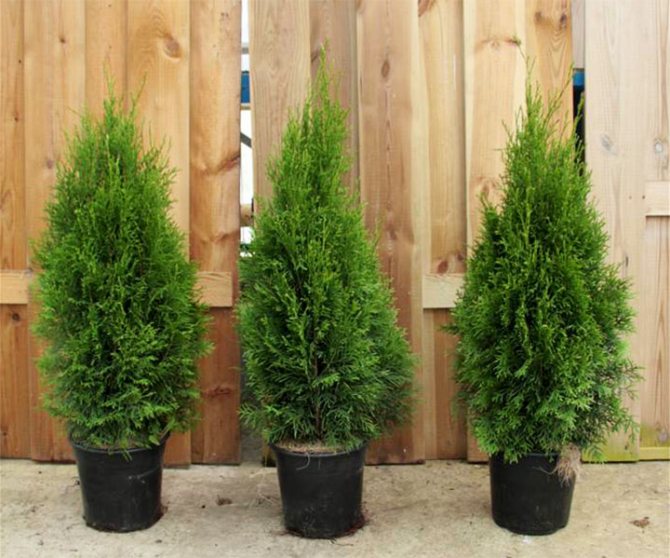

You should not buy an expensive, mature tree - it may not take root. Seedlings in a pot or with an earthen lump take root best.
How and when to trim thuja
To give the thuja crown the desired shape and maintain the health of the shrub, it is necessary to regularly prune. How to cut the thuja correctly and not harm the plant?
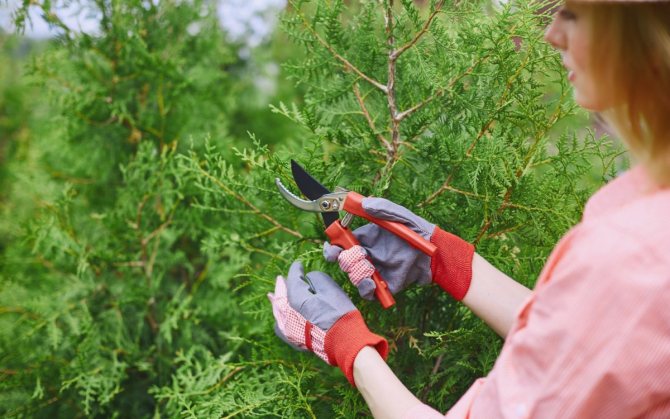

Pruning thuja
This procedure is carried out not only for aesthetic, but also for medicinal purposes.It can be divided into two types:
- Sanitary pruning. It is held in spring and autumn. The purpose of this procedure is to remove damaged branches and thin out the crown for better air permeability. It is also worth removing branches affected by diseases or parasites.
- Formative pruning. It is carried out in the period from late spring to early autumn, mid-summer is considered the best time. The result of such pruning should be a properly formed shrub crown that will meet the aesthetic requirements of its owner.
How to trim thuja depends on the growth rate of the plant, its aesthetic function and the health of the plant. For example, pruning thuja Smaragd may include only a sanitary function due to the naturally successful crown shape.
For your information! Sanitary pruning is usually done twice a year, in spring and fall, and shaping as needed.
When carrying out this procedure, there is a risk of making some mistakes that can subsequently harm the plant.
- pruning in early spring. It is during this period that the time of intensive vegetation falls, and damage to the plant in this phase can stop this process;
- too much pruning. No more than 30% of the vegetative mass should be cut off, otherwise the plant may not recover after such manipulations;
- slices close to the kidney. When pruning thuja, there are strict rules that you should adhere to. Branches growing upward are cut above the outer bud, and those directed downward are cut off above the inner one;
- exposing branches. This should also be avoided. Branches that are too exposed as a result of pruning will eventually dry out.
It is better to choose a cloudy day for pruning. After the procedure, the plant should be watered abundantly, and fertilizing with mineral or organic fertilizers will not interfere.
Note! Any manipulations with thuja should be carried out with gloves, since its branches are covered with juice and resin. Then washing your hands is very problematic.
For a plant like thuja, pruning and shaping are integral parts of grooming. You should be careful about when to cut thuja and how to do it correctly.
DIY thuja fence
To create a full-fledged hedge yourself, you need to carefully approach all stages of planting, from choosing a place to calculating the distance between plants. You also need to prepare the soil for planting, and then follow the rules of care and regularly trim the hedge to give it the required shape.
Choosing a landing site
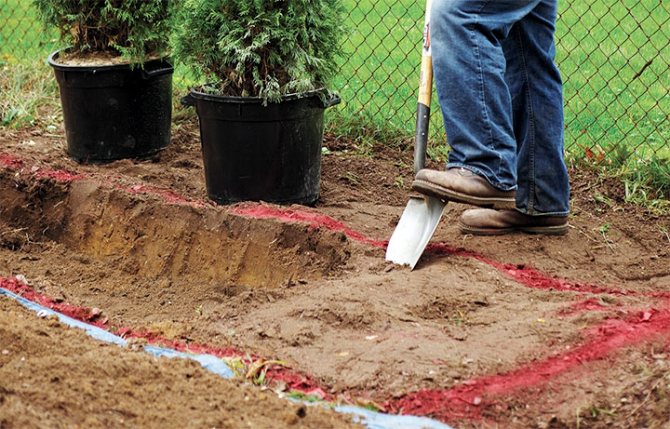

The planting site should be away from groundwater and preferably in the sun. Thuja loves her excess moisture and at the same time grows well in the sun. In the shade, the plant develops worse, and the crown looks less attractive. If the soil is heavy, then a 15 cm thick drainage layer will need to be laid on the bottom of the planting pit. Thuja can be planted in autumn and spring.
Optimal plant spacing
When planting seedlings, it is important to maintain a certain distance so that in the future the trees do not interfere with each other's growth and the hedge is formed without problems. It depends on the characteristics of a particular variety. Large ones require a lot of space, and therefore the best distance for them is 1-2 meters. When planting along a fence, the distance between seedlings can be reduced to 70 cm.
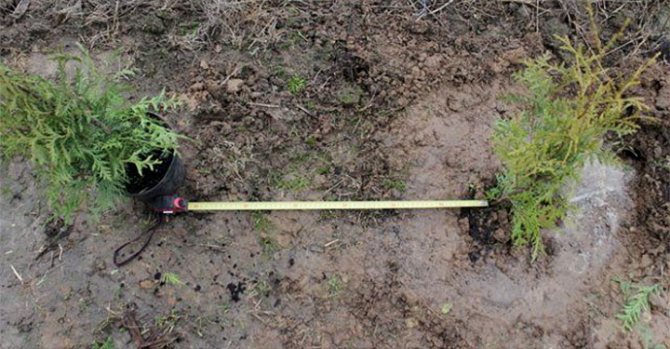

Soil preparation
For active growth, it is necessary to properly prepare the soil mixture. There are 3 options for soil mixtures for planting thuja hedges:
- Fertile soil from the site, mixed with sand and peat in a 2: 1 ratio.
- Humus foliage, sand, peat, compost in a ratio of 2: 2: 1: 3.
- Land from the forest, sand, soil from the garden 3: 1: 2, plus 100 grams of nitroammofoska.
The pit for planting undersized thuja should be 40 cm wide and 50 cm deep. For large trees, a size of 60x100 cm is convenient. For clay soils, drainage is required.It is formed from small stones, expanded clay or crushed stone, which is poured into the bottom of the planting pit. Then sand is poured and only then fertile soil.
Landing
Before planting, a thuja seedling must be placed in a bucket of water for 1-2 hours. After that, the seedling can be moved to the planting pit. It is important that the earthen lump is not destroyed. The lower part and sides of the roots should be slightly loosened so that the roots are distributed over the entire area of the planting pit.
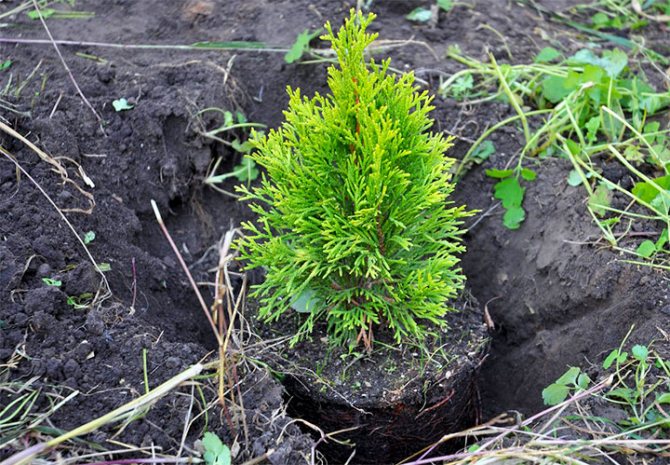

The trunk must be placed strictly vertically. If this is done even with a slight slope, then the thuja itself will also grow with a slope and spoil the appearance of the hedge. With proper planting, the root collar should be flush with the ground, and the buds should be 2-5 cm higher. After planting, it is necessary to fill the hole and water it in 2-3 doses. It is recommended to add a growth stimulant to the water for irrigation. This will allow the seedling to grow more actively.
If you mulch the soil around the thuja, you can avoid evaporation of moisture and protect the soil around the seedling from overheating. Chips, peat, bark or paper can be used as mulch.
Landing scheme
There are several schemes, each of which depends on the selected variety and what kind of hedge you want to see. Large trees are planted along a tight control rope. It will mark the line along which the holes will be dug.
For dwarf varieties, a trench is dug instead of holes. With a distance between the seedlings of 2 meters, you need not only to pull the rope, but to drive the pegs into the ground. Then the line will be smoother.
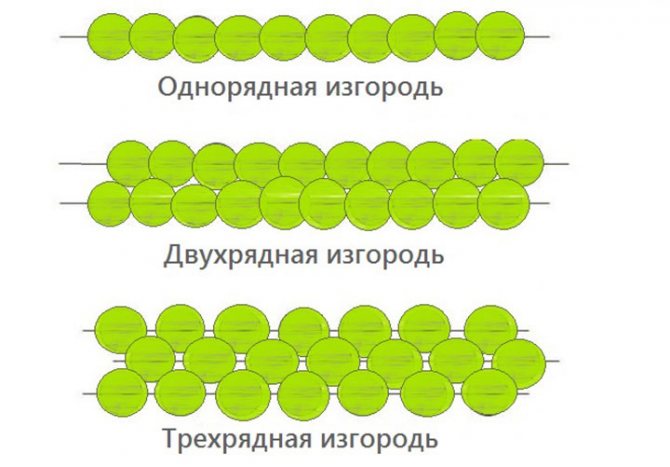

To grow a dense hedge, a two-row checkerboard planting pattern is often used. Since thuja does not like shade and develops poorly with a lack of light, it is not recommended to plant it in three rows - the middle one will develop slowly.
Thuja care
Like any cultivated plant, thuja needs care. Despite its unpretentiousness, this tree requires watering, feeding and protection from pests and diseases, especially in the first year.
In summer, it is recommended to shelter the tree from the scorching rays of the sun. When watering, you should focus on soil moisture. It is worth watering the thuja about once a week at the rate of 1 bucket of water per 1 adult plant. In the summer, it is good to additionally spray the crown. Spraying can be canceled 2 months after planting.
When planting, the plant will need mineral feeding. It will last for several years, and then you need to regularly feed the thuja in the spring with complex fertilizers. There are fertilizers designed specifically for this shrub.
Thuja belongs to frost-resistant plants, but at the same time the first winter can be destructive for seedlings. Therefore, in late autumn, young seedlings should be covered with warm specialized material. It must keep warm and at the same time retain the sun, which is no less dangerous in winter than in summer, and can burn the crown of a young tree.
Regularly, the gardener should inspect the plant for the occurrence of diseases and pests. At the first symptoms, the entire hedge should be sprayed.
The root system of a young tree should also be insulated before frost, since young roots are prone to freezing. Foliage from the site, mixed with the ground, is well suited as a heater. If you throw it around the plantings, then the roots of the thuja will completely survive the frosts of central Russia. Warming will also serve as an additional fertilizer for young plantings. It is necessary to insulate seedlings for up to three years. Mature trees will easily survive frosty winters without additional maintenance.
Thuja haircut
To maintain a normal hedge, it is recommended to cut it regularly. It is important to carry out not only formative pruning, but also sanitary.
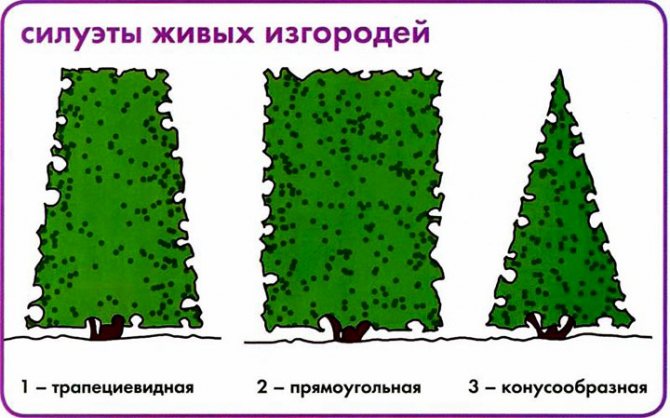

Timely and competent pruning will allow the shrub to stay healthy and develop in the right direction. The exact timing of the haircut depends on the variety.It is recommended to check these periods in the nursery when buying a seedling. It is better to cut off excess branches in the spring. Pruning that begins before bud formation may stop branch growth. For all trees and varieties of thuja, there is a general rule for cutting - you cannot remove more than a third of the total crown volume. Otherwise, the seedling will dry out and it will be impossible to restore it.
When forming the crown, it is important that the branches expand downward. Pruning shears or pruning shears are sufficient for cutting. When growing thuja in a small amount of mechanical garden shears, it will be enough to form a hedge. It is important that scissors and all other gardening tools are sharpened.
Green wall care
Forming fuchsia at home and pruning
In order for the green fence to perform its functions (decorate and protect), proper care must be organized behind it, the essence of which can be summarized as follows:
- apply mineral fertilizers during planting, the amount of which should be enough for the first two years of thuja's life in a new place;
- if possible, shade the hedge from the scorching sun in summer and spring;
- water as the soil dries, but not excessively;
- in the first winter in a new place, they must be covered;
- the root system of thuja is shallow, so the soil surface under it needs to be mulched.
The nuances of caring for young plants
Any young plants are more sensitive to unfavorable conditions than mature ones. Thuja are no exception.
Young thuja need to be grown in areas protected from direct sun. Illumination should be good, but the sun is scattered. This is one of the basic rules for planting these plants.
It is advisable to plant young thuja on fertile soils, while mature specimens are less sensitive to the composition of the soil. A mixture of sand, peat and turf works well.
If young plants were planted in late spring or summer, then they need fairly frequent watering, at least once a week, 8-10 liters (bucket) under each tree. In the heat, thuja needles actively evaporate moisture, so its reserves must be constantly replenished, otherwise the plant may die. If the temperature is above 30 ° C, then you can water it twice a week. More often it is not necessary, otherwise the thuja will start to hurt.
Within a month after planting in open ground, if the weather is hot, sprinkle irrigation. This agrotechnical procedure is carried out after sunset or long before sunrise, so that moisture has time to evaporate from the needles.
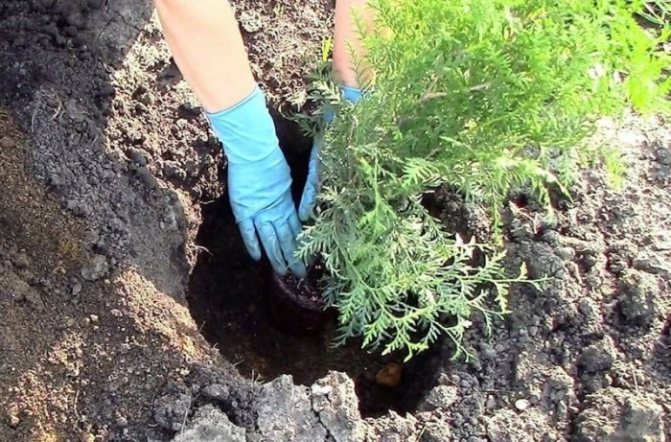

Plant in the shade
Note! If sprinkling is carried out during the day, sunburn and mucous bacteriosis are possible.
Photo gallery: living thuja fence in landscape design
A thuja fence is a great option for an evergreen hedge with a pyramidal crown. It is unpretentious in care, does not require a lot of watering, the green crown all year round is only a small part of the advantages of this plant. There are several varieties to choose from, varying in height and care requirements.
To get a good hedge, it is enough to choose a suitable variety, think over a planting scheme and take care of young seedlings. In a couple of years, they will get stronger and turn into a full-fledged living fence with minimal maintenance requirements.
Causes of plant incompatibility
Plant compatibility on the site is an important factor when organizing plantings, especially when it comes to a small area where different crops will be in close proximity. The main reasons for incompatibility are special soil requirements (in particular, its acidity), illumination, humidity of the site, as well as susceptibility to the same diseases and pest attacks.
Also, the danger is the joint planting of crops with powerful root systems, which over time will intertwine in the soil and inhibit the development of each other.Therefore, it is important to choose the right companions, for example, fruit trees are best planted with herbaceous plants and flowers.
Video: How to use conifers in landscape design
Thuja Brabant
The ancestor is the western thuja (Thuja occidentali), the plant can, in favorable conditions, reach a record height of 38 m, but usually does not grow above 20 m. At the same time, the annual growth is extremely small. The Barabant variety grows much faster - the annual growth is up to 30 cm in height and up to 10 cm in width. In urban areas, the maximum height is up to 4 m.
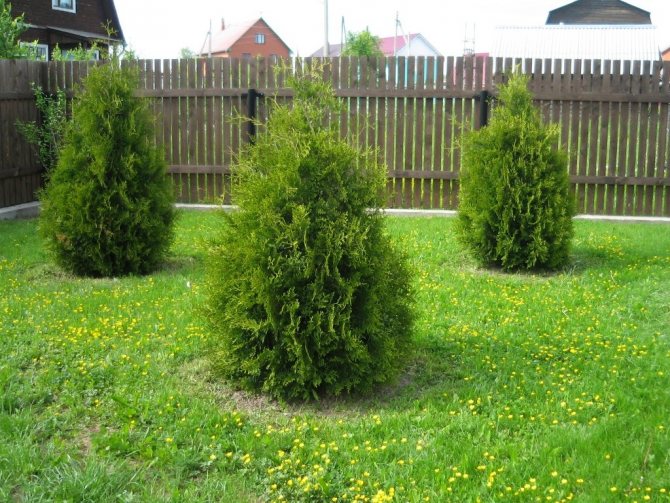

Thuja Brabant in a group landing
What do you need?
Materials and tools required for planting a green wall of thuja:
- seedlings, as a rule, are packed in pots in nurseries;
- garden tools (shovel, rake, drill, watering can or irrigation system);
- sod soil;
- compost;
- peat mixture, it can be purchased at any gardening store;
- sand;
- drainage;
- water for irrigation;
- combined mineral fertilizer;
- kraft paper;
- scissors or pruning shears for cutting hedges.

